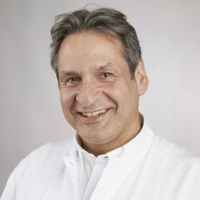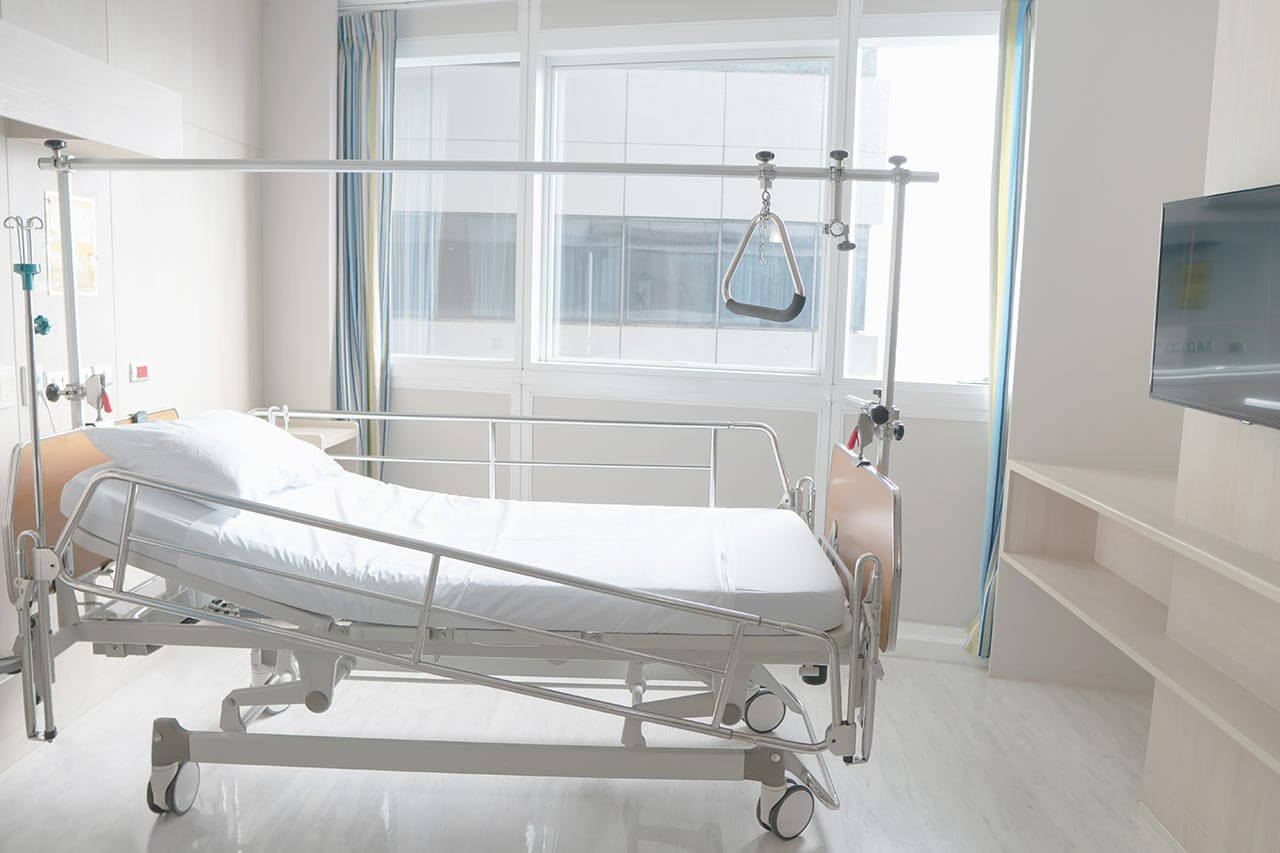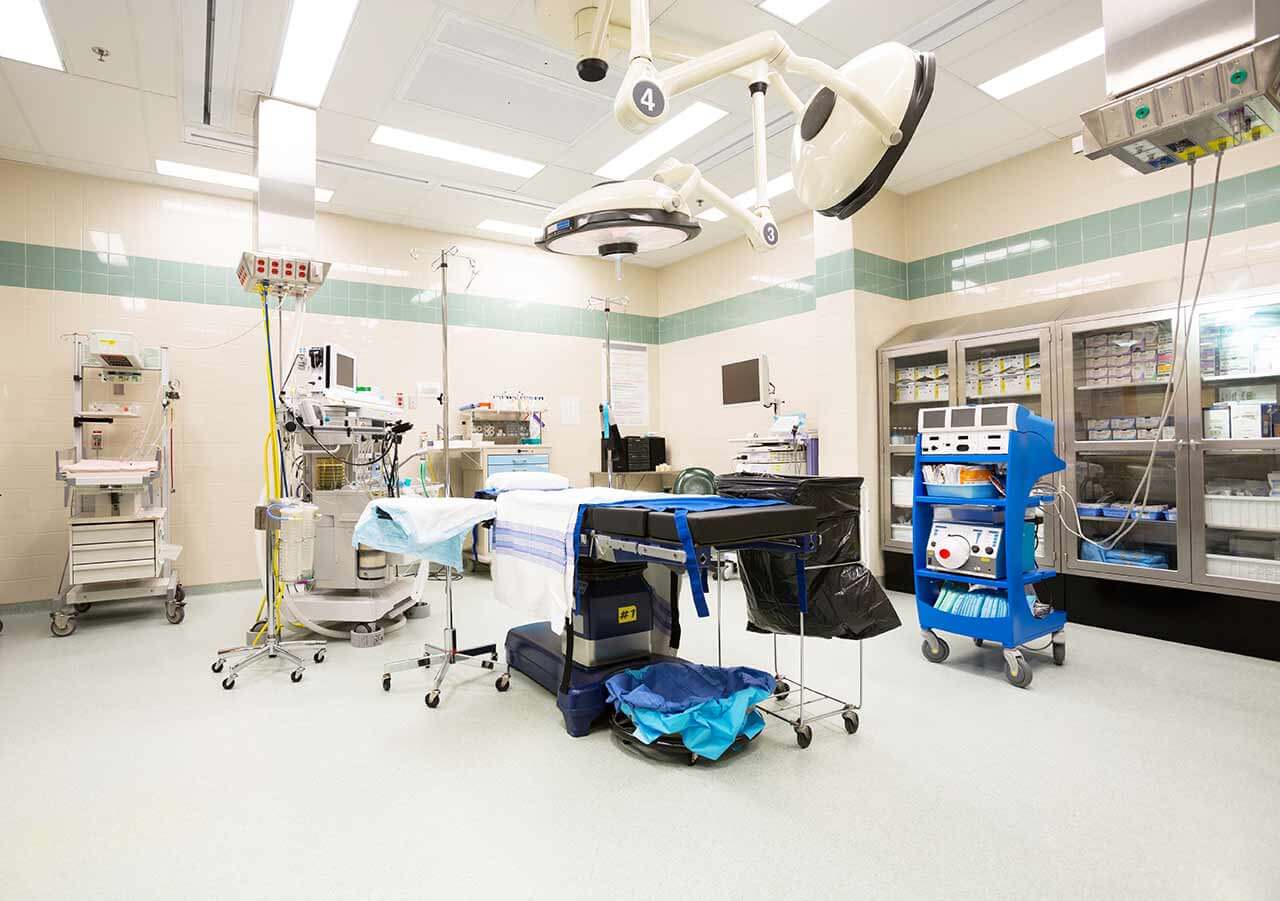
The program includes:
- Initial presentation in the clinic
- clinical history taking
- physical examination
- review of medical records
- laboratory tests:
- complete blood count
- general urine analysis
- biochemical analysis of blood
- indicators of inflammation (CRP, ESR)
- indicators blood coagulation
- x-ray examination of the hip
- MRI scan of the hip
- preoperative care
- hip replacement (hip endoprosthesis)
- symptomatic treatment
- control examinations
- physiotherapeutic procedures
- orthopedic appliances
- the cost of essential medicines and materials
- nursing services
- full hospital accommodation
- explanation of future recommendations
The program includes orthopedic rehabilitation:
- Primary presentation in the clinic
- medical history, including family history
- complex neurological and orthopedic examinations
- X-ray examination
- complex neurophysiological examinations
- individual rehabilitation program, which includes:
- Wii Fit training in the use of the balance
- neuropsychological therapy
- functional therapy of the upper extremities (ArmeoSpring)
- kinesitherapy (physiotherapy)
- biocontrol with feedback
- healing deep muscle massage
- acupuncture of spasticity and pain syndromes
- occupational therapy
- psycho-educational classes
- Individual physiotherapy
- microcurrent treatment
- fangotherapy / cryotherapy
- antispasmodic drug therapy
- mobilization of limb joints
- hydrotherapy / massage therapy / reflexology
- training on special trainers
- and etc.
- nurses care
- stay in the hospital with full board
- symptomatic and drug therapy
How program is carried out
Preliminary preparation for hip replacement includes quitting smoking and drinking alcohol; cancelling non-steroidal anti-inflammatory drugs (diclofenac, ibuprofen); cancelling anticoagulants (warfarin); normalization of body mass, if possible.
Preoperative examination, including consultation with an anesthesiologist and necessary related specialists, takes 1-2 days. According to its results, the most suitable endoprosthesis is selected.
Hip replacement. The operation is performed under general anesthesia. The patient lies on his side, the affected leg is bent and fixed in this position. The surgeon makes an incision 15-20 cm long, minimally traumatizing the muscles and nerve endings. Through this incision, miniature instruments are inserted to remove the damaged joint structures. Healthy bone is adjusted for further reliable implant fixation.
The surgeon installs a femoral stem in the center of the upper part of the femur. Ball-shaped head of the joint is fixed on it. The surgeon also implants a special liner that facilitates movement of the leg and protects the structures of the prosthesis. After the primary fixation of the prosthesis components, the doctor assesses the joint range of motion, as well as the length and symmetry of the lower limb.
The implant is fixed with cement or cementless method. The doctor treats the operating field with antiseptics, conducts its final revision and sutures the wound layer by layer. A temporary drainage is installed in the joint, and a bandage is applied on top.
Postoperative care. During the first day after the intervention the patient stays in the intensive care unit, under round-the-clock medical supervision. After that, with a smooth course of the postoperative period, the patient is transferred to a regular ward and the drains are removed. The range of motion expands gradually, from light toes movements to walking. Walking with the use of walking aids is allowed in 3-5 days after the operation.
Rehabilitation. The rehabilitation program begins after the transfer of the patient from the intensive care unit to a regular ward. It includes physical activity (from exercises in bed in the early days to exercises in the gym), physiotherapy, massage (including lymphatic drainage), exercises in the water. The rehabilitation program is constantly being adjusted according to the needs of the patient.
Required documents
- X-ray examination of the hip joints
- MRI scan of the hip joints, if available
Service
You may also book:
 BookingHealth Price from:
BookingHealth Price from:
About the department
The Department of Adult and Pediatric Orthopedics, Trauma Surgery and Arthroplasty at the DRK Hospital Berlin Westend provides the full range of medical services in the areas of its competence. The department's team of doctors treats patients with diseases and injuries of the musculoskeletal system, joints, bones, tendons, ligaments, and muscles. Orthopedists specialize in partial and total knee, hip, and shoulder replacement surgery, as well as successfully perform revision arthroplasty. Doctors perform arthroplasty at the EndoCert certified Maximum Care Center for Joint Replacement Surgery. The department also has the status of a regional Trauma Center Berlin-Brandenburg, where both common household injuries and severe multiple injuries are effectively treated. The department's team of doctors has a perfect command of advanced conservative and surgical treatment methods in the area of its specialization. Joint replacement surgery is performed here using minimally invasive techniques, which allows the patient to get back on their feet and get rid of pain as quickly as possible. The department has also gained vast experience in arthroscopic treatment of pathologies of large joints and injuries of the tendons, ligaments, and muscles. The department uses an innovative method of cartilage tissue restoration called autologous chondrocyte implantation. Patients of the medical facility receive personalized medical care in comfortable conditions.
The department is headed by Dr. med. Thilo John. The specialist is renowned as one of the best orthopedic traumatologists in Germany. He has more than 25 years of successful clinical experience. He is particularly interested in knee and hip replacement surgery and polytrauma treatment. Dr. med. Thilo John has devoted a significant amount of time to studying the behavior of cartilage tissue on biomaterials in order to grow it for transplantation.
The priority tasks of the department's team of doctors include knee, hip, and shoulder replacement surgery. Arthroplasty is most often indicated for patients with osteoarthritis, osteoarthrosis, rheumatoid arthritis, avascular necrosis of the femoral head, shoulder dysplasia, humeral head avascular necrosis, and other pathologies. Joint replacement surgery is a last-line treatment. This option is considered when other methods have failed. Preoperative diagnostics involve laboratory tests, X-rays, ultrasound, CT or MRI, and electrocardiography. If the patient has no contraindications to surgery, the attending physician determines the optimal type of joint replacement surgery – partial or total. Whenever possible, preference is given to partial replacement of joint elements because this option allows the doctors to preserve part of the patient's own joint.
It is important that almost all joint replacement surgeries are performed in the department using minimally invasive techniques. This approach significantly lowers surgical and postoperative risks, as well as allows the doctors to guarantee a rapid recovery after surgery. The department's orthopedists work only with high-quality endoprostheses from the world's leading manufacturers, which have a service life of 15-20 years. When performing the intervention, the surgeon makes small incisions in the skin and soft tissues in the area of the affected joint, removes pathologically altered tissues, implants the prosthesis, and sutures the wound. The operation can be performed under local or general anesthesia. The anesthesiologist determines the optimal type of anesthesia during the preparation for the surgical procedure. The department's surgeons often operate on patients using advanced computer navigation systems, thanks to which the most precise positioning of the prosthesis is ensured. The use of minimally traumatic surgical techniques allows the patient to get back on their feet on the day of surgery and begin rehabilitation. Experienced physiotherapists work with the patient during this phase of the therapeutic process.
The department's specialists regularly perform revision joint replacement surgery. Such operations may be indicated in cases of displacement or wear of the prosthesis elements, mechanical breakdown of the prosthesis, periprosthetic fractures, improper prosthesis implantation, or the development of infection in the area of the prosthesis. Revision joint replacement surgery is a more complex intervention than primary arthroplasty because patients most often have a bone tissue deficit, which greatly complicates implant fixation and normal mobility. The surgeon needs to remove the old prosthesis or its elements without damaging healthy tissues. The specialist has to clean the bones of cement and carefully remove metal parts used to fix the prosthesis. Revision joint replacement surgery is a complex operation that can be performed successfully only by a highly qualified and experienced surgeon.
The department is one of the few European Orthopedic Centers where autologous chondrocyte implantation (cartilage cell transplant) is practiced to restore cartilage tissue in arthrosis. The method is suitable for cartilage repair in the knee, shoulder, hip, elbow, and ankle joints. Cartilage cells are cultured using the patient's own biological material, so their properties are almost identical to the patient's own cartilage tissue, which eliminates the risk of rejection of the transplanted material.
The procedure of autologous chondrocyte implantation consists of several stages: harvesting the patient's cartilage tissue for further cultivation in the laboratory (the process takes 5-7 weeks) and the injection of the resulting biological material into the affected joint during a low-traumatic arthroscopic manipulation. The chondrocytes are then embedded into the defective joint areas to repair them. A 3-day hospital stay is required after chondrocyte transplantation. During the first six weeks after the procedure, the patient must strictly follow the recommendations of the attending physician and not load the joint.
The department's clinical focuses include:
- Partial and total knee, hip, and shoulder replacement surgery
- Revision knee, hip, and shoulder replacement surgery
- Arthroscopic interventions on the large joints, tendons, ligaments, and muscles
- Minimally invasive surgery for degenerative spinal diseases
- Minimally invasive surgery for foot diseases
- Minimally invasive surgery for hand diseases
- Autologous chondrocyte implantation (cartilage cell transplantation)
- Conservative and surgical treatment (corrective osteotomy) for traumatic injuries and bone fractures in adults and children, including complex joint fractures, pelvic and acetabular fractures, vertebral fractures, and polytrauma
- Other medical services
Curriculum vitae
Higher Education and Professional Career
- 1987 - 1993 Medical studies at the Faculty of Medicine of the Free University of Berlin.
- 1994 - 1997 Work in the Department of Trauma Surgery and Reconstructive Surgery at the Hospital Steglitz.
- 1997 - 2001 Doctor (specialization in General Surgery), Charite University Hospital Berlin.
- 2001 Board certification in Trauma Surgery; Doctor in the Department of Trauma Surgery, Charite University Hospital Berlin.
- Specialization in the care of patients with severe injuries.
- Participation in the development of ATLS standards in providing care for patients with polytrauma.
- International involvement as an Instructor for the International Association of Orthopedics (AO) and participation in operations in the Middle East.
- Since 01.10.2009 Head Physician, Department of Adult and Pediatric Orthopedics, Trauma Surgery and Arthroplasty, DRK Hospital Berlin Westend.
Clinical Interests
- Hip and knee joint replacement surgery.
- Hip joint arthroscopy.
- Treatment of severe fractures using corrective osteotomy.
Research Interests
- Cell therapy for cartilage tissue restoration.
Memberships in Professional Societies
- Professional Association of Orthopedists and Traumatologists.
- German Society of General and Visceral Surgery.
- Berlin Surgical Society.
- Berlin Medical Association.
- AO Spine.
Photo of the doctor: (c) DRK Kliniken Berlin Westend
About hospital
The DRK Hospital Berlin Westend is a modern medical facility with a rich historical heritage. It is an academic hospital of the Charite University Hospital Berlin, one of the most prestigious medical facilities in Europe and worldwide. The medical complex is part of the DRK Kliniken Berlin Group, which has a history spanning more than 150 years. The work of the hospitals in this group is based on the principles of the Red Cross. Structurally, the hospital consists of 15 departments, 12 highly-specialized centers, and numerous laboratories and institutes. Almost all areas of modern medicine are represented here. Innovative developments are regularly implemented into clinical practice, and medical care conforms to current international standards.
The hospital underwent a major renovation in 1991, after which it received a modern design with high standards of comfort and state-of-the-art medical equipment, significantly impacting the effectiveness of treatment. The health of patients is in the safe hands of a large team of doctors and nursing staff, consisting of more than 1,000 employees. All specialists are highly motivated and have excellent education and clinical experience. More than 80,000 inpatients and tens of thousands of outpatients are treated here every year. Such a large number of patients is the best confirmation of the successful work of the medical center.
The architecture of the building in which the hospital is located deserves special attention. The medical facility enjoys the reputation of being not only one of the best in terms of medical service but also one of the most beautiful. The hospital is located in a building constructed in the early 20th century, surrounded by a picturesque garden and meadow. Additionally, in close proximity to the hospital lies Charlottenburg Palace, which is one of Germany's most significant and luxurious castles, representing unique cultural value.
Photo: (с) depositphotos
Accommodation in hospital
Patients rooms
The patients of the DRK Hospital Berlin Westend live in comfortable rooms with light colors. Each patient room has an ensuite bathroom with a shower and a toilet. The patient room furnishings include an automatically adjustable bed, a bedside table with a pull-out tray, a table and chairs, a wardrobe, a TV, and a telephone.
Patients can also be accommodated in enhanced-comfort single rooms, if desired.
Meals and Menus
The patients of the hospital are offered three delicious and balanced meals a day: breakfast, lunch, and dinner. The menu always includes dietary and vegetarian dishes.
There is also a cozy cafe on the premises of the hospital where one can have a light meal. The menu includes cold and warm snacks, salads, and desserts. Hot and cold drinks are also served here. During the warm season, the guests of the cafe can relax on a beautiful terrace.
Further details
Standard rooms include:
Religion
Religious services are available upon request.
Accompanying person
Your accompanying person may stay with you in your patient room or at the hotel of your choice during the inpatient program.
Hotel
You may stay at the hotel of your choice during the outpatient program. Our managers will support you for selecting the best option.




